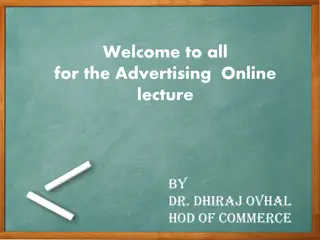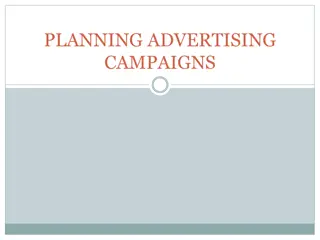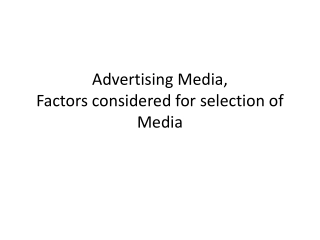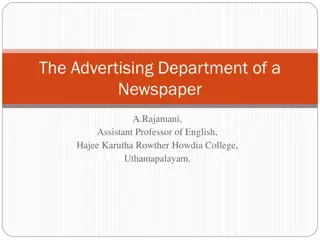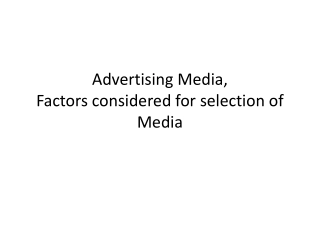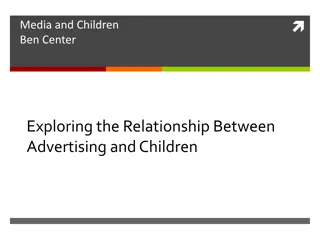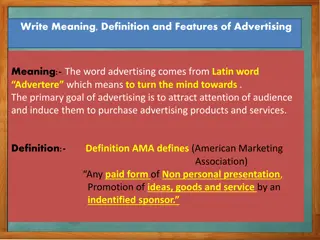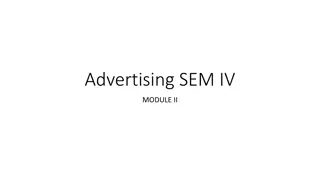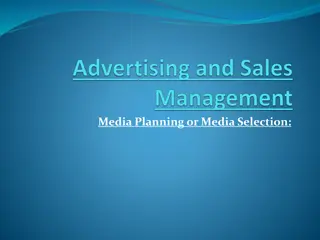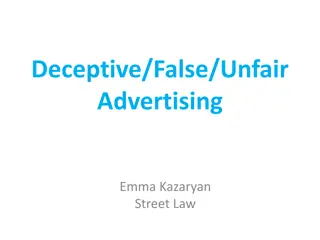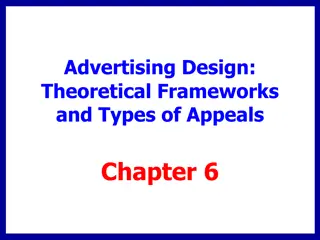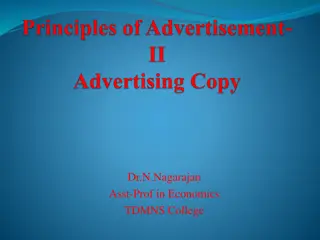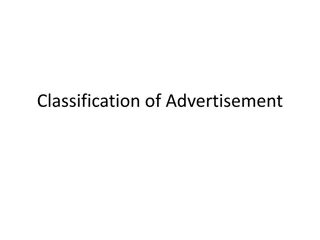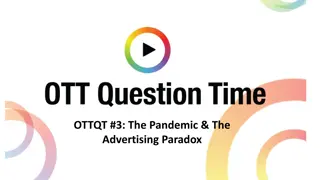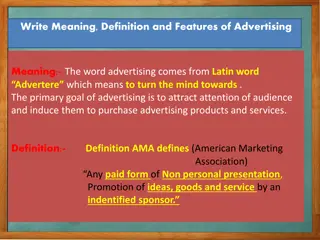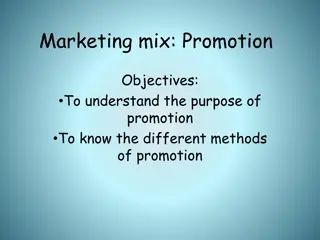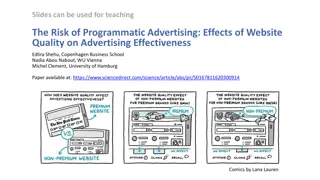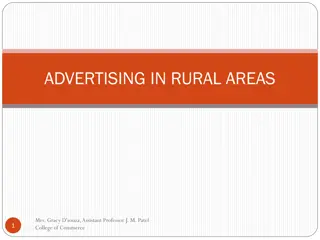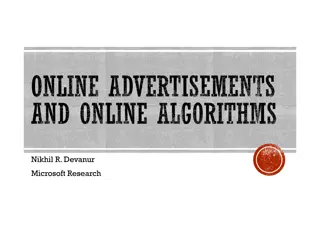Understanding the Features and Objectives of Advertising
Advertising plays a crucial role in promoting products and services to target audiences. It involves paid, non-personal communication to inform, educate, and persuade consumers. The objectives include promoting sales, educating the public about products, and creating demand. Through identified sponsors, advertising aims to attract customers and maximize profits by effectively delivering messages through various mediums.
Uploaded on Sep 26, 2024 | 0 Views
Download Presentation

Please find below an Image/Link to download the presentation.
The content on the website is provided AS IS for your information and personal use only. It may not be sold, licensed, or shared on other websites without obtaining consent from the author. Download presentation by click this link. If you encounter any issues during the download, it is possible that the publisher has removed the file from their server.
E N D
Presentation Transcript
Features, Objectives and Functions of Advertising
Meaning of Advertising It has originated from Latin word adver which means to turn the mind toward . Dictionary meaning of the term is to give public notice or to announce publicity . In general, Advertisement is a mediumof impersonal sales efforts. It is a technique of popularising one s product or services.
Defination Of Advertising Any paid form of non-personal presentation or promotion of ideas , goods or services, by an identified sponsor. American Marketing Association Advertising is mass communication of information intended to persuade buyers so as to maximise profits. Littlefield and Krikpatrick
Features Of Advertising 1. Paid Form Of Communication -- Advertiser pays the amount to newspaper, magazines, televisions, radio etc., to purchase the space or time to communicate with the prospective customers. 2. Non Personal Presentation OfMessage -- Does not come face to face. -- it is read, seen or listened by the customers.
3. Promotion Of Product The purpose of the product is to promote the product or services in order to increase the sales of product or service. 4. Sponsored By Identified Person These are sponsored by identified persons. It should disclose or identify the sources of opinions and ideas it presents.
Objectives and Functions of Advertising 1. Promotion Of Sales Advertising is undertaken to create demand for new and existing products and services. It informs people about the new products and persuading them to go for particular products. An effective advertising will help in attracting more and more customers.
2. Educate Public About Product Advertisement not only promote products but they also educate public about their proper use. Products may sometimes be put to some alternative uses or some additional uses . This is brought to the notice of public and it may fetch more customers.
3. Introduction Of New Product Whenever a new product is introduced in the market, it must be brought to the notice of the public through advertisements. A new product cannot make an impact in the minds of the customers without the help of advertising. Advertisements are helpful in quick publicity of products.
4. Overcome Competition Every product is facing not only national but also international competition. In order to survive in competition, the good features of the product should be brought to the notice of the public. So advertisements will help in overcoming competition from other products.
5. Mass Production Large scale production will be possible only if there is a market for the products . Product market can be possible if the product is widely advertised. Mass production will help in reducing production through economies in various expenses. So advertising is required if production is to be increased.
6. Research And Development Advertising stimulates research and development activities. In the prevailing competitive environment every producer has to differentiate its products from alternative/substitute products available in the market. This will be possible only if regular research is undertaken on the product and attracting more customers for the same.
Importance Of Advertising Advantages To Manufacturers 1. Create demand for new product. 2. Increases the sales and profits. 3. Creates goodwill. 4. Creates steady demand. 5. Facilitates quick turnover of goods. 6. Reduces cost of production. 7. Reduces cost of distribution. 8. Increases labour productivity.
Advantages To Consumers 1. Increase personal satisfaction. 2. Better standard of living. 3. It helps in reducing the prices. 4. Increases the utility of commodities. 5. Saves consumer s time. 6. Ensures good quality of product. 7. Consumer cannot be cheated. 8. Prompts the consumer to work hard and learn more.
Advantages To Salesmen 1. Creates proper base for the salesmen. 2. Educates salesmen and increase their confidence, capacity and initiatives. 3. Simplifies work. 4. Reduces the efforts. 5. Increases the remuneration.
Advantages To The Society 1. Uplifts the standard of living. 2. generates gainful employment opportunities. 3. provides new horizons of knowledge. 4. provides a regular source of income to newspapers. 5. transforms culture of a nation. 6. act as a barometer of a nation s economic growth.
Limitations Of Advertising 1. - As advertisement cost is included in product cost. - it has been said that, every advertisement is a nail in the customer s coffin . 2. It Misleads People And Act As An Instrument Of Cheating -Sometimes conceals the facts to induce the buyer to buy inferior products. Increases The Price Of The Product Or Services
3. It Creates And Breeds Monoplies - It creates brand preference which makes customers sheer slaves of such brands, resulting in creation of monopolies. - It enables manufacturer to exploit customers. - Becomes difficult for new firms to sell their product which kills the competition.
4. Sheer Waste Of Resources - Wastage of resources as most of the advertisements are ignored. - Does not create new demands but only shifts demand from one product to another. - half used and old articles are often rejected. 5. Produce A Society Of Greedy, Self Centerd People - People forgot moral and social values.
5. It Multiplies The Needs Of The People, Encourages Extravagance And Creates Dissatisfaction - Creates dissatisfaction and frustration. - people may not hesitate to fulfill their demands through corrupt practices. 6. It Encourages Vulgarity, Cupidity, Indecency And Basd Taste - Advertisements are full of sex appeal, vulgarity and stupidity which exploits the emotions of people.
Advertising Media The term media refers to the means through which the advertising information is communicated by the advertiser to the prospective customers. It may be classified under two categories -- Direct advertising -- Indirect advertising
Direct advertising -- It aims at reaching directly the known prospects and is done through direct mail advertising. Indirect advertising -- Under this public is indirectly approached through a well chosen media such as films, television, radio etc.
The principal media of advertising that are commonly used are discussed below ; 1. Press Media It refers to the publication of the advertisement in newspapers, magazines, and journals. a large number of national, local and state newspapers; magazines are there in which these kind of advertisements appear as it is most economical, effective and elastic method of enlightening people
(A) Newspaper It is the best medium for those who desire to reach general public quickly and at short interval. Newspapers have a wide circulation and are very effective. They are said to be the backbone of all advertising program.
(B) Magazines and Journals -- These are the periodicals published weekly, fortnightly, monthly, quarterly or yearly to be read in leisure hours. -- These are of various types like ordinary magazines which are read by all classes and special magazine such as women magazine and children magazine. -- Journals are devoted to various subjects such as commerce, management etc
2. Outdoor Media -- It refers to the display of advertisement in open places wherefrom people generally pass through such as railway stations, bus stands etc... The appeal of this advertisement takes a mass form as many people move out of doors every week.
It embraces the media like; Posters Painted displays Electrical arrangements Traveling displays Sky-writing Sandwichmen
3. Postal or Direct Mail Advertising It is a way of transmitting information or message direct to potential customers through the medium of post. Such advertising reaches the public free of cost for them and is generally read indoor. The important direct mailing media are card, sales letters, circulars, leaflets, calendars, booklets, etc.
4. Other Media (A) Films It is very popular and consist of a wide range from ordinary slides to short films and feature films produced for specific purpose. One find such advertisements before the film start or in intervals.
(B) Radio It is the cheapest and most pervasive off all mass communication. It is even effective in rural area. Advantages 1. It is alive and quite dramatic. 2. It effects the mind and is more receptive. 3. It has human appeal. 4. It requires little effort on the part of listener. 5. It provides a variety of programmes that can be hired as per the needs of advertiser.
Limitations 1. It is an expensive media of advertising. 2. It has a temporary effect. 3. It dos not provide pictorial presentation. 4. It is not suitable for all kinds of product. 5. Its message is brief and sometimes not clear.
(C) Television Latest and fastest. More effective than radio or other methods. Enough scope of variety. It is catchy. Coverage is more. Provides pictorial presentation. It is very expensive.
(D) Window Display They are the face of the shop which constitute the first impression of the establishment. they are used to attract person into the shop by arousing their interest. Advantages 1. Provides actual life-size presentation of demonstration. 2. save the time of shopkeeper. 3. adds to the beauty of shop. 4. it appeals at the time of purchase and has immediate effect.
(E) Interior Display and Showrooms Prospective consumers have the opportunity of visiting the showrooms at their leisure and have careful glance over the item displayed. The success of the media depends upon suitable locations and proper layout of the showroom. This helps the customers to inspect and buy the goods immediately.
(F) Fares and Exhibitions These are become more popular not only in cities but also in rural areas. These are held in a central places where mass can reach easily. The sellers are given opportunity to display the product and provide ready market. The customers study the various products and have the knowledge of market.
Nature Of Product - Product needed by all : print, telecast, outlook. - Product which needs demonstration:- television, cinema screen. - Industrial products:- print media.
Nature Of Market - The market may be local or national. - Local : local cable, local regional newspapers. - National : magazines, television and cinemas.
Ciculation Of Media - All India newspapers have wide circulation so a advertisement for a national market can be better suited in news media. - National market : covered by certain magazines. - Television can also be used for advertising mass products.
Types Of Audience - If audience is illiterate :- radio, television and cinema. - If audience is educated :- newspaper, magazines. - advertisements in the language of particular regions will be more effective.
Advertising Objectives - The objective will influence the type of media to be used. - If national market is to be covered :- television will be useful. - If regional markets needs to be covered :- newspaper will be helpful.
Availability of Fund - The amounts of funds available will influence the type of media used. - Television is considered to be costly but its impact may be better. - Even in media , funds will influence its category.
Life Of Advertisement - The life of advertisement in newspaper, television and radio is short. - whereas the impact of outdoor display, magazines or direct mail may be longer. -the advertiser should take into account the duration for which he wants to create a impact on consumers mind.
Media Used By Competitor - An advertiser should carefully study the moves of competitor. - Media used by competitor should be used if same type of products are to be advertised so that the customer may be distracted from the influence of earlier advertisement.
What Makes an Ad Great? Explicit objectives should drive the planning, creation, and execution of each ad. An ad is great to the extent that it achieves its objectives, not because it wins awards. Creativity for its own sake does not always lead to great advertising. 43
Characteristics Of Great Ads Good or Great Ads Work on Two Levels Satisfy the Customer s Objectives by Engaging Them & Delivering a Relevant Message Achieve the Sponsor s Objectives
Dual Process of Great Advertising: Reaching Objectives Consumer s Objectives Advertising Objectives Satisfy Curiosity/Memory/ Entertainment Attention/ Awareness Interest Identify Personal Needs Knowledge Gather Relevant Information Support Risk Associated With Attitude Change Attitude Change Behavioral Change/ Trial Enhance Need Reduction Repurchase/Commitment/ Reminder Reinforce Trial and Need Reduction
Broad Dimensions That Characterize Great Advertising The Ultimate Test for the Greatness of An Ad is Whether It Achieved Its Goals. Creativity Strategy Execution
Measuring an Ads Success Consider one item as the measure of an ad s success: How well does it achieve its goals? Some typical goals include the following: Increased sales Attitude change Heightened brand awareness



